Family : Antennariidae

Text © Giuseppe Mazza

English translation by Mario Beltramini
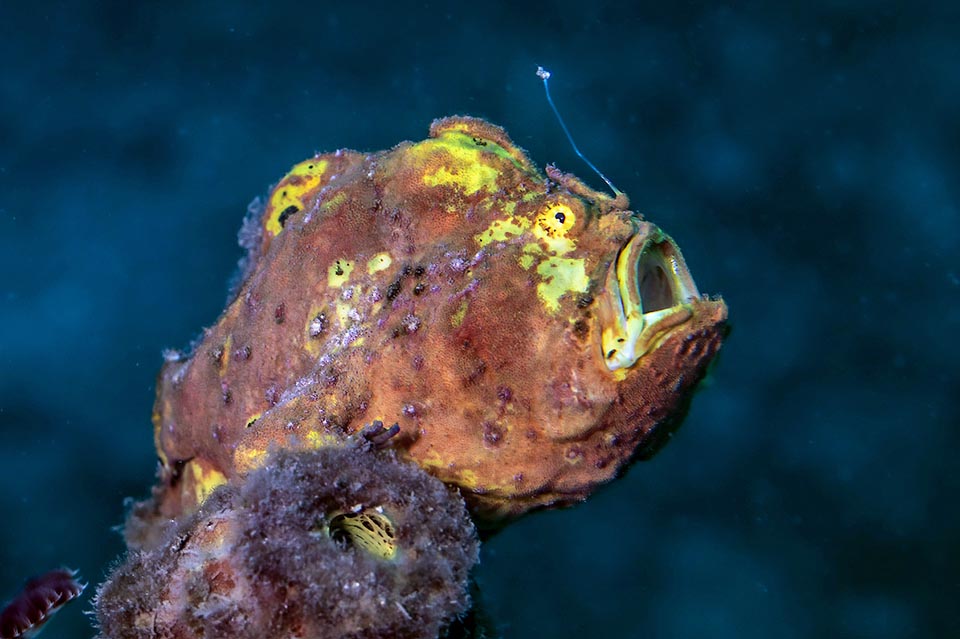
Antennarius multiocellatus is present in the American Atlantic coasts, from Bermuda to Brazil, but we find it even in the middle of the ocean at Ascension Island © Allison & Carlos Estape
Known as Longlure frogfish, Antennarius multiocellatus (Valenciennes, 1837) belongs to the class of the Actinopterygii, the ray-finned fishes, and to the order of the Lophiiformes.
They are animals who were circulating already at the beginning of the Tertiary, nowadays united in 18 families: Antennariidae (see Antennarius commerson, Antennarius pictus and Antennarius striatus), Brachionichthyidae, Caulophrynidae, Centrophrynidae, Ceratiidae, Chaunacidae, Diceratiidae, Gigantactinidae, Himantolophidae, Linophrynidae, Lophichthyidae, Lophiidae (see Lophius piscatorius), Melanocetidae, Neoceratiidae, Ogcocephalidae (see Ogcocephalus radiatus), Oneirodidae, Tetrabrachiidae and Thaumatichthyidae.
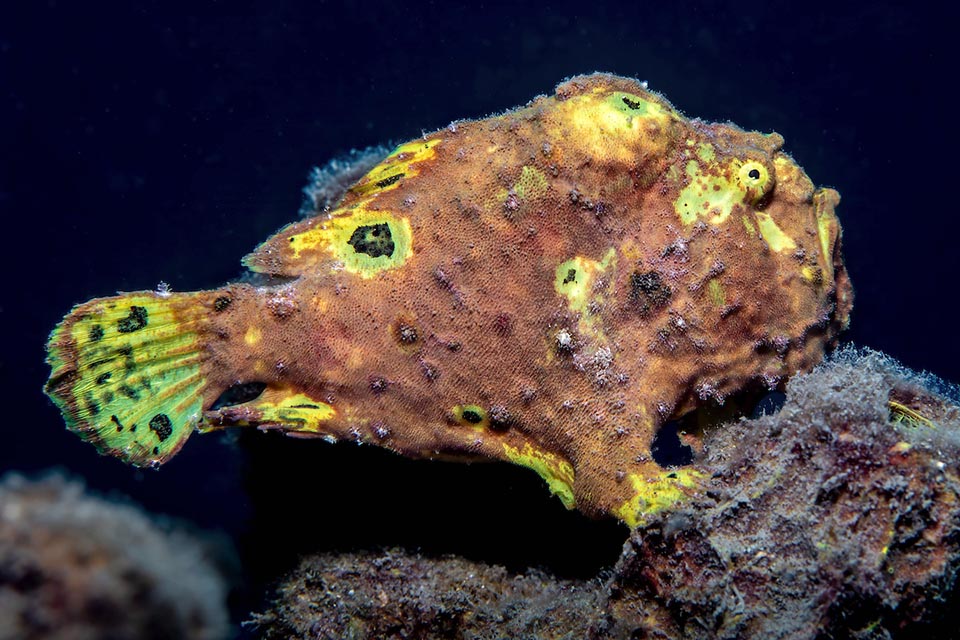
Here it is entering the scene with a leap on the pectorals used as the pelvic like legs © Allison & Carlos Estape
They are benthic species with the first spiny ray of the dorsal fin, placed on the head, that has transformed into a mobile fishing rod, complete with a luminescent bait in the abyss, to attract towards a huge mouth the passing bay fishes looking for food.
They live in all the oceans, between 20 and more than about 1000 m of depth, with dimensions varying from 3 cm to 2 m of the famous Angler (Lophius piscatorius) that has given, due to the size and the notoriety, the name to the order.
The genus Antennarius originates from the Latin “antenna”, meaning flagpole, antenna, with reference to the fishing rod we talked about before, whilst the specific term multiocellatus evokes, always on Latin, the numerous ocelli of the livery.
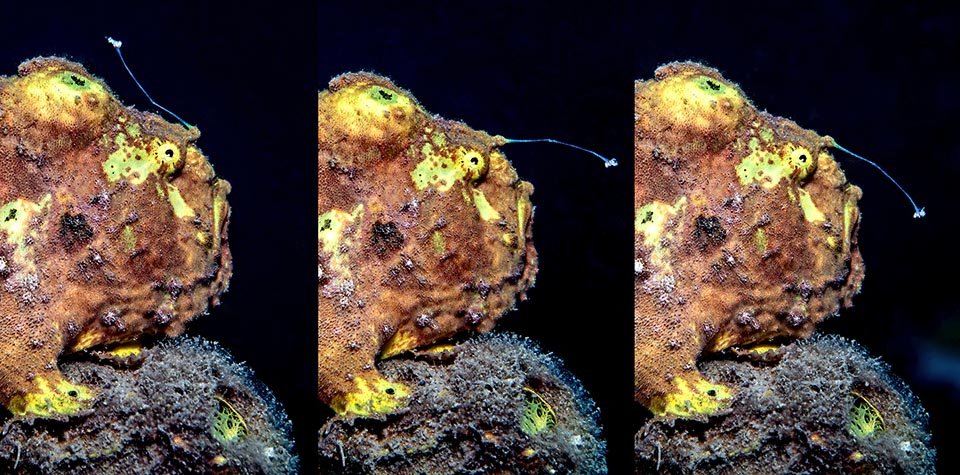
It has found a good place and tries to attract attention of small passing by preys moving its fishing rod up and down © Allison & Carlos Estape
Zoogeography
Antennarius multiocellatus has a vast diffusion in the western Atlantic, from Bermuda islands to Brazil, but we find it also in the island of Ascension, in the middle of the ocean, halfway to Africa.
Ecology-Habitat
It is a species associated with the coral reefs, found even at 66 m of depth but usually living in shallower waters camouflaged among the sponges.
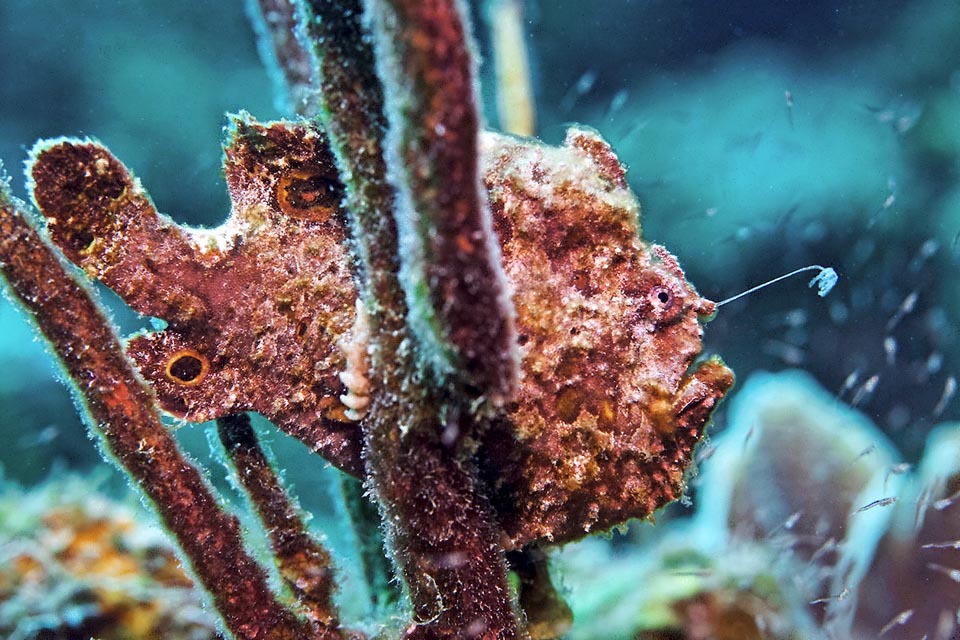
This is luckier because the small fishes abound but it could swallow in 6 thousandths of a second a fish of its size © Allison & Carlos Estape
It perfectly imitates its colour and look with ist skin and the ocelli similar to oscula, the holes these invertebrates use for the oxygenation. Moreover, it can swell with water or flatten in order to assume as much as possible the same shape.
Morphophysiology
Antennarius multiocellatus as a whole appears with a massive and rounded body. When still, it is very difficult to see it, to understand where the tiny eyes or the huge half closed mouth stand. The pectoral and the pelvic fins have transformed into legs, and the skin, elastic and wrinkled like that of a frog, has no scales and has swellings looking like warts.
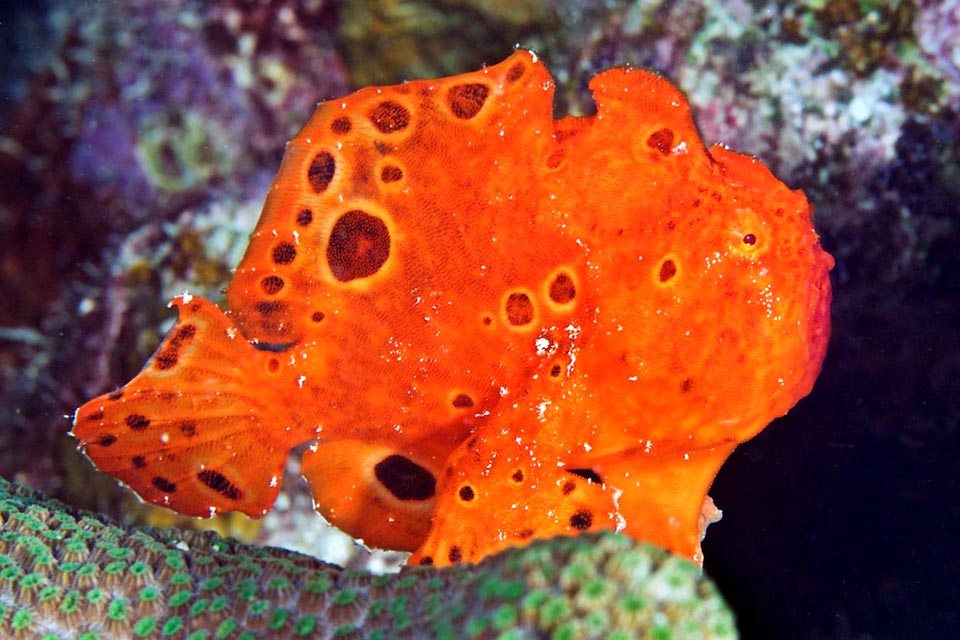
Typical is the big ocellum placed under a series of smaller occelli of the dorsal fin divided in four sections: the first has the spine transformed in fishing rod, the second is a thin fleshy protuberance with a spine; the third has a great outgrowth that hides a spine, whilst the last one, elongated, has, like the anal, only unarmed rays © Allison & Carlos Estape
Except the ocelli, that in every fish stand always at the same place and form an important element for the determination of the species, the background colour is extremely variable.
It can be grey, white, black, yellow, violet, green, brown or flame red like in the showy specimen pictured above.
Characteristic and always present is the big ocellus located towards the tail, under the series of smaller ocelli of the dorsal fin, analogous to that of the anal fin. But there are also some on the other fins and on the body.
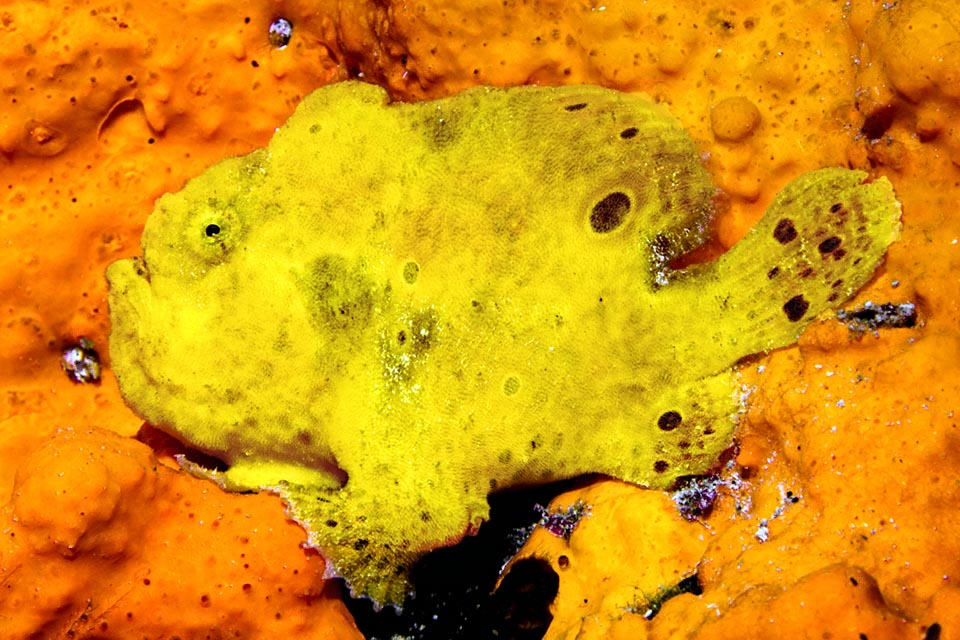
Here, main ocellum apart, these are less numerous and the background colour is definitely different © Brian Cole
Antennarius multiocellatus adapts to the environment better than a chameleon. Unlike other fishes, however, this meticulous change is not instantaneous and may require even weeks. Moreover, slow and lazy as it is, to this frogfish the fast changes in colour are not needed, because once found the right place it is able to remain there even one month.
It moves only when it sees that the fishes are not biting, as anyone fishing with the line would do among the humans.
Antennarius multiocellatus called not by chance “with long lure” often distinguishes from its congeners also for the size of its fishing line, called illicium, with on top a bow that may be mistaken for a little worm, a small crustacean or a small fish.
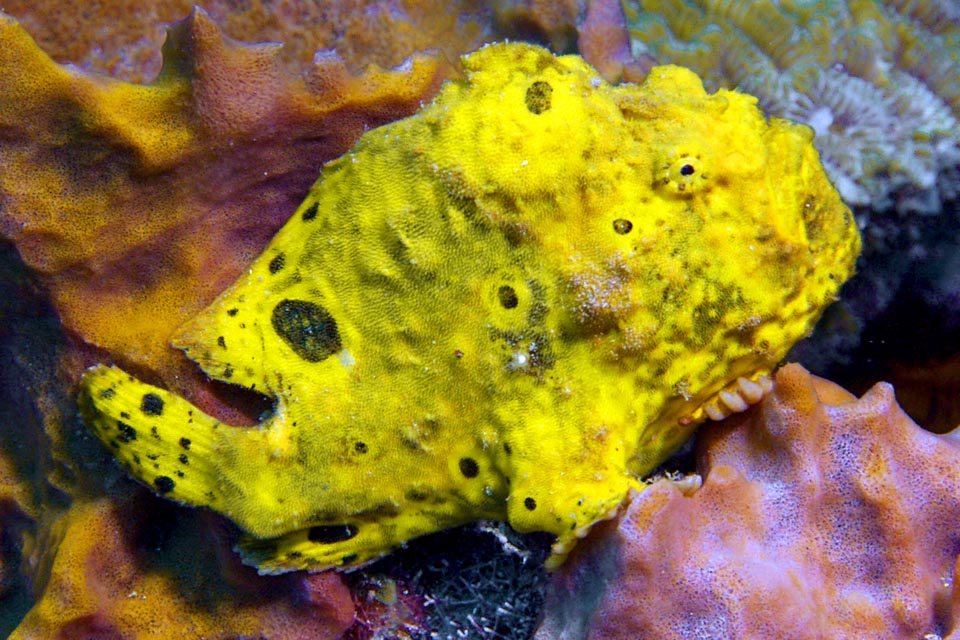
Better than a chameleon or other fishes, Antennarius multiocellatus livery can assume any colour imitating even in details the surrounding sponges, but the change is not instantaneous and may require weeks. On the other hand it’s a decidedly lazy fishy who is not in a hurry, and when it finds a fishy site stays there for a long time © Allison & Carlos Estape
As soon as it sees a prey, it moves the bait up and down, and when the prey, curious, is within range, opens wide the huge protractile mouth and sucks it at the speed of 6 milliseconds.
If it has not already ended up into the stomach, where there is room due to the elasticity of the skin for a fish of its size, the prey is held by villiform, thin teeth, grouped in bands like the hairs of a brush and rolled up for the swallowing, when it’s long, as if nothing were happening.
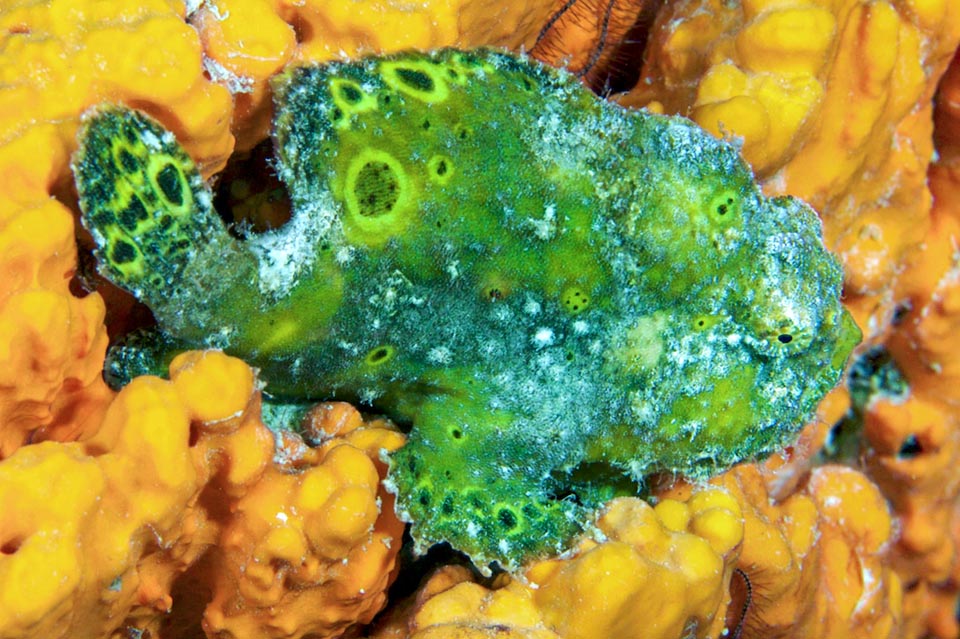
This green was clearly passing by, photographed while moving ahead on the pectorals to show us its profile on a neat contrasting bottom © Allison & Carlos Estape
The dorsal fin, practically divided in four sections, counts totally 3 spiny rays and 11-12 soft ones.
The first section is the one of the illicium, born from a modified spine and more than twice as long than that hidden in the second fleshy protuberance.Then comes the third section, more consistent, also with a hidden spine, and finally the fourth having a normal look and less adipose, having only unarmed rays like the anal and caudal fins.
The pectoral and pelvic ones transformed into limbs serve it for moving, climbing and anchoring to the madrepores, whilst the caudal is used only for short flashes or for escaping.
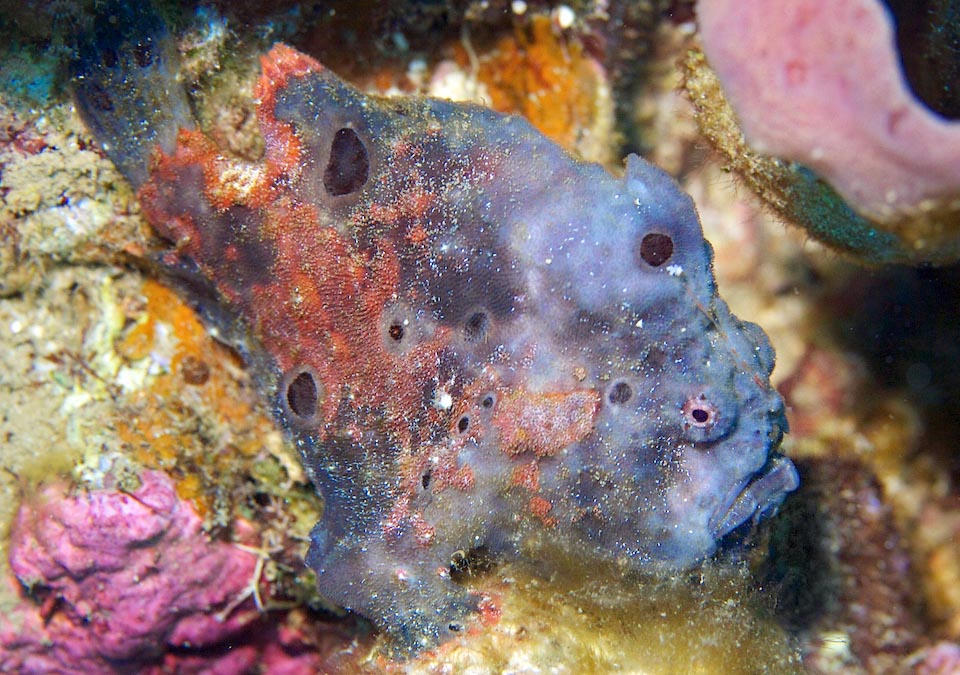
Antennarius multiocellatus may also appear white, black or spotty. Here a blue livery that probably is getting the hues of the adjacent sponges © Allison & Carlos Estape
Ethology-Reproductive Biology
Antennarius multiocellatus eats mainly fishes, but also crabs and slipper lobsters.
For the reproduction the male, smaller than the female swollen with eggs, first of all must be careful of not being mistaken for a prey.
Usually, it follows the female carefully and when this, full of eggs, goes up with blows of tail in the overlaying water column for spawning, the male helps her in the manoeuvre pushing her upwards from under the belly.
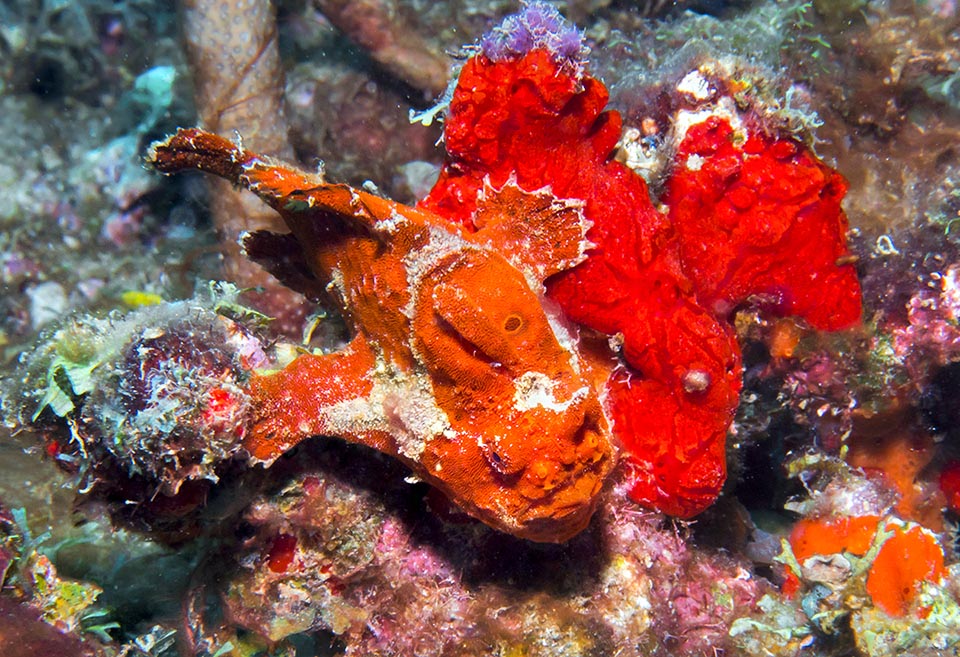
A couple. The male, smaller than the female swollen with eggs, must be first of all careful of not being mistaken for a prey. It follows her and she goes up with a leap in the water column for emitting a cloud of microscopic eggs glued together by a gelatinous mucus helps her pushing her under the belly and fecundates on the fly © Brian Cole
In short, before letting herself fall to the bottom, the partner emits, almost exploding, a cloud of microscopic eggs tied by a ribbon-like sheath or simply stuck together by a gelatinous mucus aor that the male fecundates on the fly.
The currents act like a rolling pin and the cloud visibly transforms into a carpet, called “egg raft”, that moves away, twirling elegantly, towards other shores.
Hatching occurs after a few days and the planktonic larvae wander for a long time carried by the currents who spread the species.
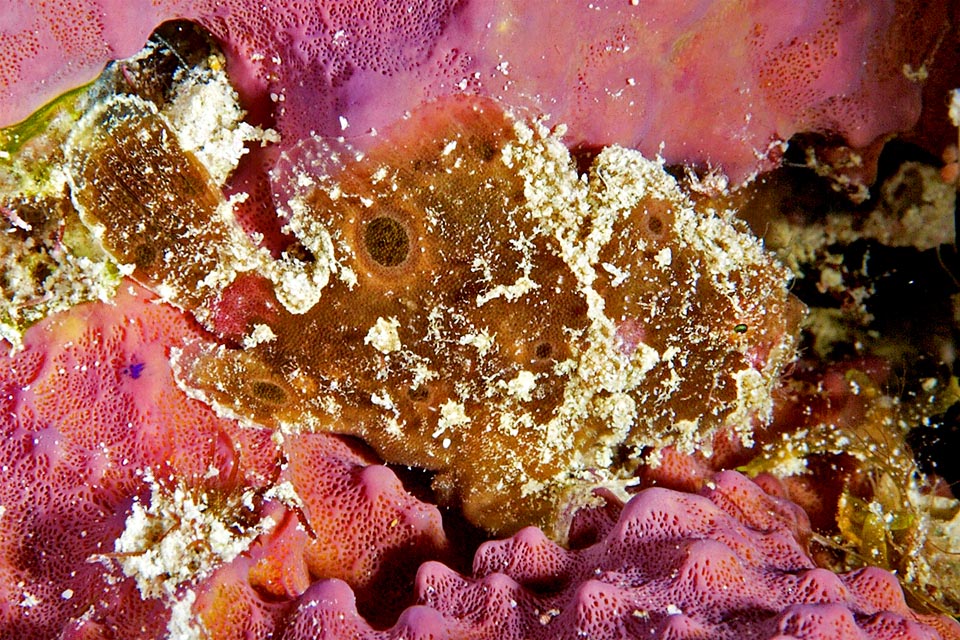
Due to the currents the gelatinous mass transforms in a few seconds in a flying carpet, called “egg raft”, that goes away twirling elegantly towards other shores. Also the larvae wander for a long time in open seas spreading the species. Here a juvenile showing already, well camouflaged, the adults’ characters © Allison & Carlos Estape
Antennarius multiocellatus has an excellent resilience, with a possible doubling of the populations in less than 15 months. The index of fishing vulnerability, very low, marks only 10 on a scale of 100 and appears in the IUCN Red List of the endangered species as “Least Concern”, that is, with “Minimal Concern”.
Synonyms
Chironectes multiocellatus Valenciennes, 1837; Chironectes principis Valenciennes, 1837; Chironectes pavoninus Valenciennes, 1837; Antennarius annulatus Gill, 1863; Antennarius corallinus Poey, 1865; Antennarius stellifer Barbour, 1905; Antennarius verrucosus Bean, 1906; Antennarius astroscopus Nichols, 1912.
→ For general information about FISH please click here.
→ For general information about BONY FISH please click here
→ For general information about CARTILAGINOUS FISH please click here.
→ To appreciate the BIODIVERSITY of BONY FISH please click here.
→ To appreciate the BIODIVERSITY of CARTILAGINOUS FISH please click here.
